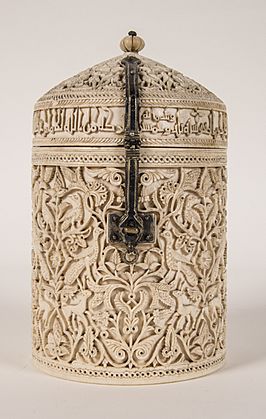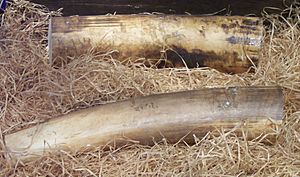Pyxis of Zamora facts for kids
Quick facts for kids Pyxis of Zamora |
|
|---|---|
| Bote de Zamora | |

Click for a three dimensional view.
|
|
| Material | Elephant ivory |
| Created | Before 964 CE |
| Period/culture | Caliphate of Córdoba |
| Present location | National Archaeological Museum (Madrid) |
The Pyxis of Zamora is a beautiful small box made from carved ivory. It was created in the year 964 CE (which is also 353 in the Islamic calendar). This special box, also called a pyxis, comes from a time known as the Caliphate of Córdoba. It measures about 17.7–11 centimetres (7.0–4.3 in). Today, you can see it at the National Archaeological Museum of Spain in Madrid, Spain.
Contents
What is the Pyxis of Zamora?
This round, carved box was ordered by the Umayyad ruler, Al-Hakam II. He had it made in 964 CE for Subh, who was the mother of his sons, Abd al-Rahman and Hishâm. The pyxis was likely made in the royal workshops of Madinat al-Zahra. It was meant to hold special items like makeup, jewelry, or perfume.
Why was this Pyxis important?
This portable box shows how fancy and advanced the ruling class was during the Caliphate of Cordoba. During this time, the Umayyads in Spain (also called al-Andalus) were trying to be as powerful as the Abbasid society in Baghdad. They also wanted to regain the power they once had in Damascus.
In Cordoba, the Umayyads ordered many amazing buildings and luxury items. These included beautiful fabrics and ivory carvings, like the Pyxis of Zamora. The designs on many pyxides from this period showed that the Umayyads believed they were politically better than the Abbasids. This pyxis, made in the smart city of Cordoba, shows how skilled the artists of the Cordoba Caliphate were.
Who was Abd al-Rahman?
The birth of Prince Abd al-Rahman was a big deal. People celebrated it with poems and art. The Arabic writing around the lid of the Pyxis of Zamora says: "The blessing of Allah upon the Imam, the servant of Allah, al-Hakam II al-Mustansir billah, Commander of the Faithful. This is what he ordered to be made for the noble lady, the mother of Abd al-Rahman under the direction of Durri as-Saghir in the year 353 [964 AD]". Abd al-Rahman was named after his grandfather, Abd al-Rahman III.
How was the Pyxis made?
Carving ivory was a common art form in the Mediterranean world. This practice started even before the Roman Empire. Ivory was very expensive because it came from far-off places like sub-Saharan Africa and India. The Umayyad Caliphate brought the tradition of carving pyxides to Spain when they took control in the 8th century AD. There is no proof of ivory box carvings in Spain before their rule.
The Art of Ivory Carving
The quality of pyxides was very important because ivory was so costly. A sign of excellent work was that you couldn't see any tool marks. Carving small objects like pyxides needed great care and a lot of time. This also added to their high price. The Pyxis of Zamora shows this high quality. It has a deep-relief pattern with designs that weave together. You can't see any tool marks on it. Other pyxides from the same time, like the Pyxis of al-Mughira, show similar carving skills. Because they were so expensive and rare, only royalty could own pyxides.
Design and Decoration
Round pyxides, like the Pyxis of Zamora, were made using the natural curve and hollow part of a thick elephant tusk. Round pyxides were less likely to warp than square boxes. This is because the circular shape kept the tusk's natural strength. The smooth surface of the Pyxis of Zamora allowed for one continuous design.
The interlacing pattern and the Arabic writing on the lid were special. The writing told who ordered the pyxis and who it was for. These details encouraged the person holding it to turn the object around. This way, they could fully admire the amazing craftsmanship. The decoration also made people want to open the box. The beautiful outside hinted at the precious things inside, like perfume or jewels.
See also
 In Spanish: Bote de Zamora para niños
In Spanish: Bote de Zamora para niños


